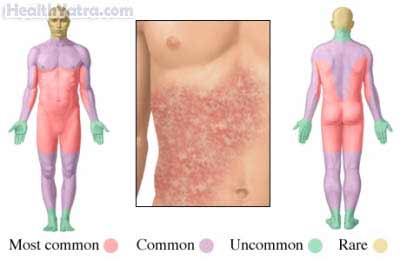Definition
Anaphylaxis is a severe, sometimes life-threatening, allergic reaction. It affects multiple organs, including the heart and lungs.
It is important to seek medical care right away if you have symptoms of anaphylaxis.
Causes
Substances that cause anaphylaxis are often called allergens or triggers. Common triggers include:
- Foods and food additives, especially eggs, peanuts, seafood, cow’s milk, soy, fish, shellfish, seeds, and tree nuts
- Insect stings or bites from bees, wasps, hornets, yellow jackets, and fire ants
- Medicines (eg, antibiotics, seizure medications, muscle relaxants)
- Vaccines
- Latex products (eg, gloves, medical tubing, condoms)
- Blood transfusion
- Some pain medicines, especially narcotics

Some triggers, like dyes used in x-ray procedures, can cause a reaction similar to anaphylaxis.
Risk Factors
These factors increase your chance of developing anaphylaxis. Anyone can have anaphylaxis. Tell your doctor if you have any of these risk factors:
- Previous allergic reaction to the substances listed above, even if it is a mild reaction
- History of eczema, hay fever, or asthma
- Children who have certain conditions, such as spina bifida and urogenital defects may be at increased risk for latex allergy (because of heavy exposure to latex during multiple surgeries)
Symptoms
The symptoms of anaphylaxis usually occur within minutes after exposure to an allergen, but can occur hours later. Symptoms may be mild or very severe, including death. They include:
- Hives and itching
- Warmth or redness of skin
- Swelling, redness, stinging or burning, especially on the face, mouth, eyes, or hands
- Lightheadedness, pale/blue skin color, low pulse, dizziness
- Obstruction of the nose, mouth, and throat
- Severe respiratory distress (eg, chest tightness, shortness of breath, wheezing)
- Nausea, vomiting, cramping, diarrhea, or abdominal pain
- Heart arrhythmias
- Convulsions
- Low blood pressure
- Shock
- Feelings of anxiety
Diagnosis
The doctor will suspect anaphylaxis if you have symptoms and have been exposed to a likely allergen. It is also important to follow up with a doctor who specializes in allergies (allergist/immunologist). The diagnosis of allergy with a risk of anaphylactic reactions is made based on the patient’s history. It is confirmed with skin tests and sometimes blood tests done by allergy specialists.
Treatment
Anaphylaxis is a medical emergency that requires immediate medical treatment, including:
- Epinephrine (adrenaline) injection—makes blood vessels constrict, relaxes the airway, stops itching and hives, and relieves gastrointestinal cramping
- Other medicines—corticosteroids and/or antihistamines may be given after the epinephrine to decrease inflammation and improve breathing.
- Bronchodilators—to improve breathing
- IV fluids—to maintain blood pressure
- Oxygen
- Cardiopulmonary resuscitation (CPR)—may be necessary in severe cases when anaphylaxis leads to cardiovascular collapse. Severe anaphylaxis may requiremechanical ventilation until swelling is brought under control.
NOTE: If you receive emergency epinephrine, you should go to the emergency room right away, even if your symptoms have gone away.
If you are diagnosed with anaphylaxis, follow your doctor’s instructions .
Prevention
Avoiding substances that trigger anaphylaxis is the best prevention. In addition:
- Allergy shots can decrease the risk of anaphylaxis and reduce the severity of the reactions to certain triggers.
- Wear a medical alert bracelet that lists your allergies.
- Tell your doctor or dentist about your allergies before taking any medicine. When possible, ask that medicines be taken as a pill. Allergic reactions can be more severe with injected medicines.
- Your doctor may give you self-injectable epinephrine kit to keep with you at home, work, in the car, and when you travel. Be sure family and friends know how to use the kit too. Get training from your doctor and practice using it in the doctor’s office.
- Make sure your epinephrine kit is not expired.
- Make sure the school nurse and teachers know about any allergies your child has. If your child has self-injectable epinephrine, make sure school staff knows how to use it and understand when it is needed.
- If you are allergic to insect stings, wear protective clothing when outside.
- Always remain in the doctor or dentist’s office 30 minutes after you have an injection. Report any symptoms right away.
Anaphylaxis Treatment in India – Page Keywords:
Anaphylaxis Definition, Anaphylaxis Definition Causes, Anaphylaxis Symptoms, Anaphylaxis Treatment in India, Anaphylaxis Treatment Cost in India, Anaphylaxis Surgery Cost, Top Anaphylaxis Treatment Hospital, Top Anaphylaxis Treatment Doctor in India, Anaphylaxis Meaning in Marathi, Anaphylaxis Treatment Near me, Anaphylaxis Complications, Travel India for Anaphylaxis Treatment, Anaphylaxis Treatment in Arab Countries, Anaphylaxis Treatment in Bangladesh, Anaphylaxis Treatment in Dhaka, Anaphylaxis Meaning in Bengali, Anaphylaxis Meaning in Arabic, Anaphylaxis Meaning in Hindi, Anaphylaxis Treatment in Bahrain, Anaphylaxis Treatment in Egypt, Anaphylaxis Treatment in Iraq, Anaphylaxis Treatment in Jordan, Anaphylaxis Treatment in Kuwait, Anaphylaxis Treatment in Lebanon, Anaphylaxis Treatment in Saudi Arabia, Anaphylaxis Treatment in United Arab Emirates, Anaphylaxis Treatment in Sudan, Anaphylaxis Treatment in Tunisia, Anaphylaxis Treatment in Nepal, Anaphylaxis Treatment cost,
